Click any photo for a larger version.
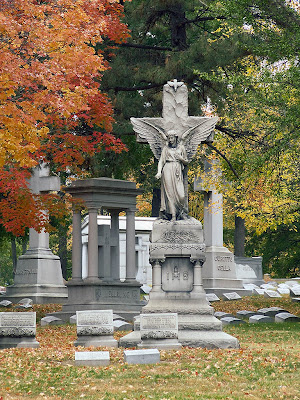
Absolve, Domine, animas omnium fidelium defunctorum ab omno vinculo delictorum et gratia tua illis succurente mereantur evadere iudicium ultionis, et lucis æterne beatitudine perfrui.Calvary Cemetery is in the northern part of the city, and is designed in a park-like manner that was common in the Victorian era.
Forgive, O Lord, the souls of all the faithful departed from all the chains of their sins and may they deserve to avoid the judgment of revenge by your fostering grace, and enjoy the everlasting blessedness of light.
If you look at a map of Saint Louis, you will see no cemeteries in the older part of town, while there are numbers of cemeteries, like Calvary, clustered around the edges of the city. From a history of the cemetery:
After the cholera outbreak in 1849, an official city ordinance required that all new cemeteries be located beyond the city limits. At the time, there was thought that such a measure might stay the rising number of cholera victims. Most of the city's cemeteries, including all of its Catholic cemeteries had been filled to capacity due to the epidemic. Archdiocese records showed that on one day alone, June 25, 1849, 99 of 126 total burials were attributed to cholera. St. Louis Catholics were in need of another, larger burial ground.
In 1853, Archbishop Peter Richard Kenrick purchased 323-acre "Old Orchard Farm" northwest of the city from Kentucky politician Henry Clay. Kenrick established his own farm on half of this acreage and dedicated the other half to the development of a new cemetery. As the cemetery grew, more acreage was added to its site. Part of this property had once been used as an ancient burial ground by Native Americans and soldiers from nearby Fort Bellefontaine were also interred there. After its purchase, these remains were collected and buried in a mass grave under a large crucifix. It is located at one of the highest points of the cemetery.
Kenrick lived in the mansion on the western grounds for many years. Calvary was established on the eastern portion of the property and its association, the Calvary Cemetery Association, was incorporated in March 1867. Archbishop Kenrick was the association's first president. Graves from many of the Catholic cemeteries in the city such as Rock Springs and Holy Trinity cemeteries were reinterred in Calvary. The cemetery now contains over 315,000 graves in its 477 acres.
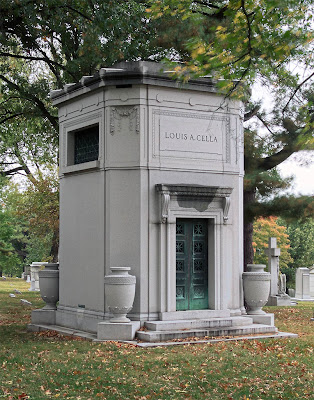
Somber and dignified tombs cluster around the main cemetery entrance, most in the neoclassical style. These seem to be about a century old, and are for the most part, the last of their kind, marking an interruption in the tradition that goes back to the remotest of antiquity.
Modern practice is concerned with efficiency and low cost, making monuments smaller and cheaper, even though our nation has more wealth and power than any other culture in the history of the world. This trend is now being driven to its heretical and sacrilegious end in parts of Europe, where the practice of anonymous burial is being pushed as a progressive cause: no monuments, no relics, even no means of visiting graves is seen as a way of forgetting and repudiating the past and our inevitable fate.
Contemporary funerals are notorious for their excessive cost, extracted quickly from mourning relatives during times of emotional instability, and for being controlled by revenue-hungry corporations rather than stable family businesses. It would seem that the money would be better spent in the traditional manner, as seen here.
The tradition helps us to uphold the communion of saints, by our remembering and praying for the departed, and encouraging the veneration of relics, as well as serving as a memento mori.
Funerary customs change with time, but we hope that they remain more rooted in the eternal faith rather than in the ephemeral spirit of the age.
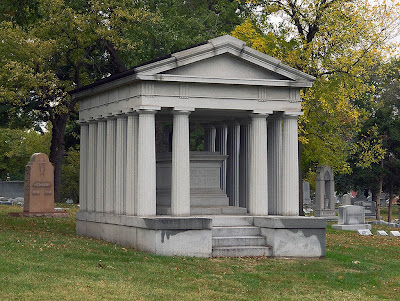
Tomb in the form of a Greek temple, not housing an idol of a false god, but rather entombing relics of those who were made in the image and likeness of God.
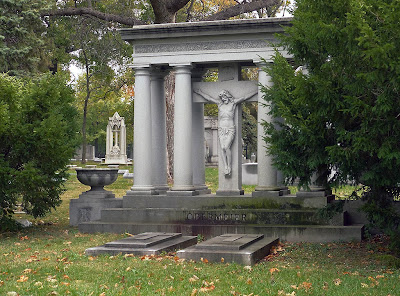
Peccantem me quotidie, et non me pœnitentem, timor mortis conturbat me : Quia in inferno nulla est redemptio, miserere mei, Deus, et salva me.
It is upon such an one as myself, who doth sin often and repent seldom, and then but little, that the fear of death befalleth : Because in hell there is no redemption, have mercy upon me, O God, and save me.

Two female androsphinxes guard the entrance to an Egyptian-style tomb. Such a design would perhaps be more appropriate in the Masonic Bellefontaine cemetery, which adjoins Calvary to the south. However, we can be generous and recognize that the ancient Egyptians took the afterlife very seriously.

Audivi vocem de cælo dicentem mihi,
Beati mortui qui in Domino moriuntur.
I heard a voice from heaven, saying unto me.
Blessed are the dead, which die in the Lord.

A Romanesque-style tomb, made of pink granite, rather than of the more common gray granite found here.

Ego sum resurrectio et vita : qui credit in me, etiam si mortuus fuerit, vivet; et omnis qui vivit et credit in me, non morietur in æternum.
I am the resurrection and the life : he that believeth in me, though he were dead, yet shall he live; and whosoever liveth and believeth in me shall never die.
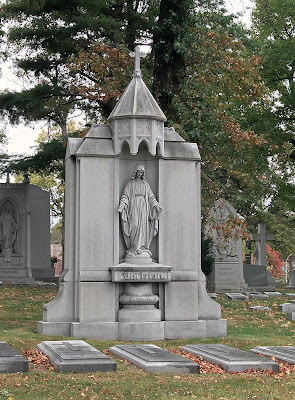
Many, if not most, of the monuments here feature explicitly Christian symbolism, and the older ones tend to be the most explicitly Catholic. The century-long trend towards secularism in the cemeteries as well as everywhere else, needs to be reversed.

The cemetery's large mausoleum, dating from 1961. It houses two Catholic chapels and a very large number of tombs.

This chapel is round, with an ad orientum altar against one wall. Not shown here is the verticality of the sanctuary; inspired by some of Constantine's early churches, it is very tall, surrounded by a side-aisle, covered by a dome, and lit by cleristory windows high up on the walls.

Tombs are placed in side-rooms; each named after a patron saint, and most are illumined by modern stained glass windows.

Statues of Mary and Joseph, and the marble floor is decorated with seven-pointed stars.

While this cemetery is somber, it lacks the explicit imagery and exposed relics often found in Europe, or even in older American graveyards, and as such it anticipates the often timid liturgies of the dead promulgated in recent decades.
Address:
5239 West Florissant Avenue
Saint Louis, Missouri 63115


No comments:
Post a Comment